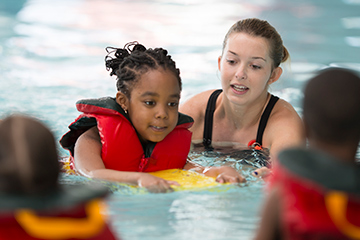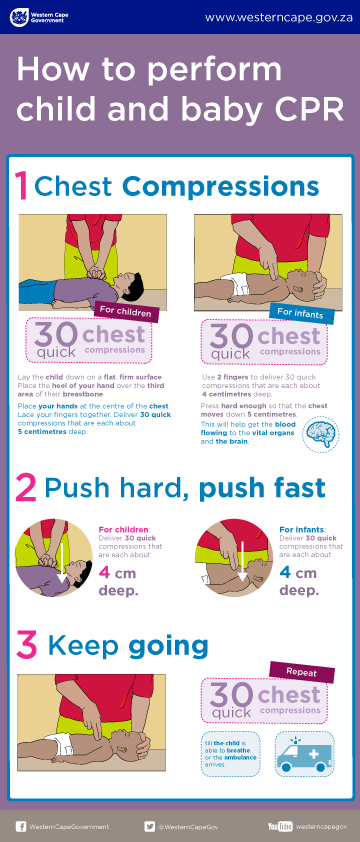Tips to prevent child drownings
 Water games and pool activities can be fun for children, but it can also be dangerous when they're left unattended.
Water games and pool activities can be fun for children, but it can also be dangerous when they're left unattended.
Drowning is serious and poses a public health threat. According to Statistics South Africa, fatal drowning is the 5th leading cause of unintentional death in the country.
According to the Department of Health's Forensic Pathology Service, 39 children between the ages of 1 month to 14 years have drowned in the Western Cape between January and November 2022. Most of these drownings happened either at sea or in swimming pools.
What happens to your body when you’re drowning?
Did you know that drowning can happen within 20 seconds? When someone drowns, they experience extreme breathing difficulty because they are submerged in water/liquid and their airways are being blocked.
It’s common to panic as you try and hold your breath while struggling to stay above water. Once you begin to swallow water/liquid, your reflux responses will be triggered which causes you to cough.
With a lack of oxygen being delivered to the brain, it can take a few minutes before severe damage occurs.
"Dry" drowning and secondary drowning
Dry drowning happens when a child inhales in water through the nose or mouth, causing the vocal cords to go into a spasm. This type of drowning is called “dry” drowning because water doesn't reach the lungs. Dry drowning becomes fatal because the vocal cords don't relax and airways are blocked which makes it difficult to breathe.
Secondary or “delayed” drowning happens when water enters the lungs, causing inflammation or swelling. The swelling can occur hours or even days after the initial incident. Death from delayed drowning is due to swelling of the small air sacs in the lungs, preventing oxygen from entering the bloodstream.
Signs of a possible drowning
A drowning child may not be able to call for help, so it’s best to be aware of the signs:
- The child is floating with their face down in the water.
- The child’s head is tilted back and their mouth is open.
- The child is gasping for air.
- The child is trying to swim in a particular direction and isn’t making any progress.
To keep your children safe in and near the water, follow these guidelines:
- Always make sure that your child is being supervised by a responsible adult while swimming or playing with or around water.
- Teach your kids to swim. Enroll children in age-appropriate swim lessons to help protect them from drowning.
- Learn cardiopulmonary resuscitation (CPR) and rescue techniques. Your CPR skills could save someone’s life.
- Medical conditions such as epilepsy increase your risk of drowning. If your child have epilepsy or experience seizures, make sure that they’re always supervised.
- Always be prepared and know what to do in case of an emergency. Save all emergency numbers on your cell-phone or nearby for easy access.
Learn CPR and rescue techniques
Although drowning can be fatal, your child can survive if they get help immediately.
Knowing how to administer CPR to a child or infant who is drowning could help to save their life. Note that once the child’s heart has stopped for 8 to 10 minutes, the chance of survival is slim.
Don’t risk your own life and safety when trying to rescue the child. Rather use a flotation device like a life jacket or noodle. Once the child is safely out the water you can begin to administer CPR.
This involves a combination of chest compressions known as hands-only CPR.
The following CPR procedure is for children between the age of 12 months and 8 years old.
- Chest compressions:
Lay the child down on a flat, firm surface. Place the heel of your hand over the lower third area of their breastbone and give the child 30 quick chest compressions. Press hard enough so that the chest moves down 5 centimetres. This will help get the blood flowing to the vital organs and the brain.
- Push hard, push fast:
For children: Place the heel of one hand on the center of the chest, then place the heel of the other hand on top of the first hand, and lace your fingers together. Deliver 30 quick compressions that are each about 4cm deep.
For infants: Use 2 fingers to deliver 30 quick compressions that are each about 4cm deep.
- Keep going:
Repeat the 30 compressions till the child is able to breathe or the ambulance arrives.
More information
For more information on the prevention of drowning and water safety in the Western Cape, please read the Western Cape Drowning Prevention and Water Safety Strategy.
- Cardiopulmonary resuscitation (CPR) (Public Information)



